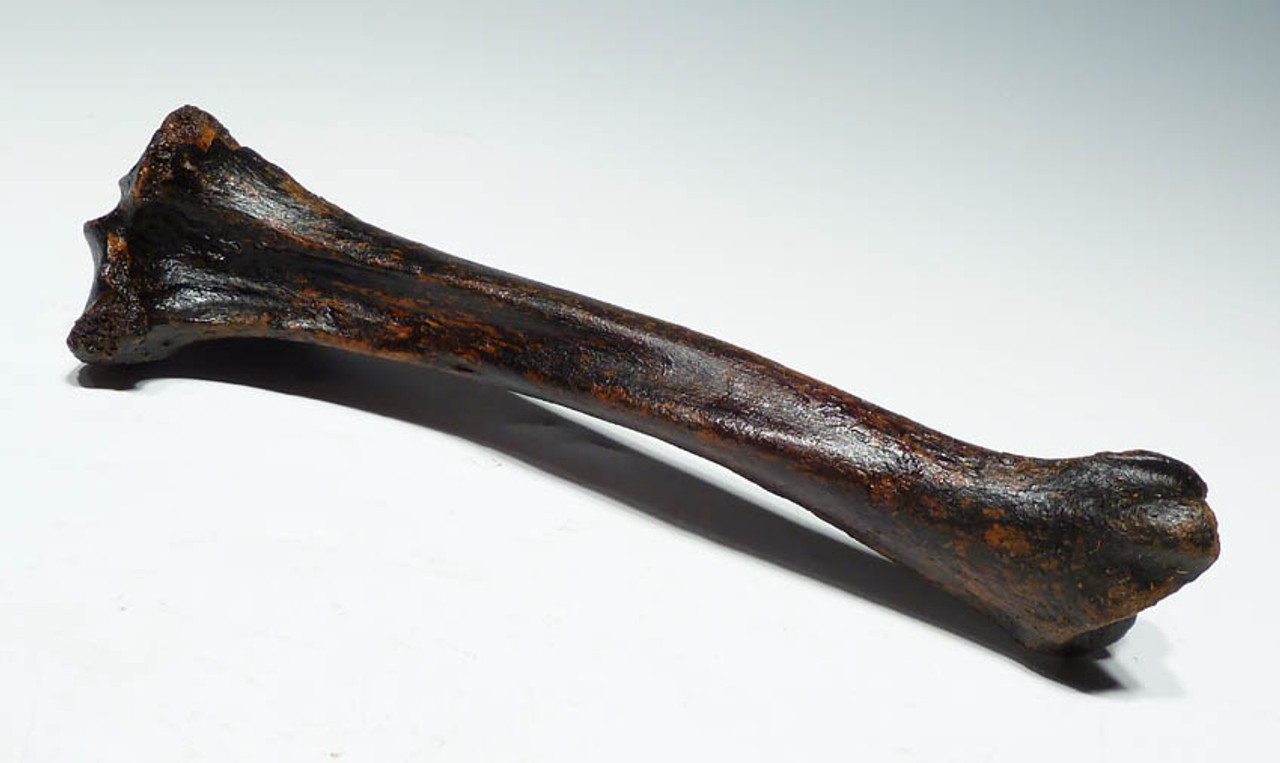Product Description
ITEM #
|
LMX054
|
||
ID
|
Crocuta crocuta spelaea
|
||
FOUND
|
North Sea, Holland
|
||
AGE
|
PLEISTOCENE: 400,000 - 20,000 years ago
|
||
SIZE
|
7.5" long
|
||
CONDITION
|
NO REPAIR OR RESTORATION - STABILIZED
|
||
NOTE
|
MAJOR LIMB BONE OF ONE OF THE MOST
|
||
Actual Item - One Only
Comes with a certificate of authenticity / information sheet |
|||
Fossils of the Giant European Cave Hyena Crocuta spelaea, are an EXTREMELY RARE find. Most preserved remains are fragments of teeth. With stringent collecting and digging laws in place now throughout Europe where the Giant Cave Hyena is found, new finds and prospecting is illegal and strictly enforced. Besides, prior to collecting laws, most of these cave deposits had been virtually cleaned out of their fossils by intense digger activity. Even if you could legally explore caves in Europe today and search for such fossils, a find such as this is a thing of the past. Such a fossil as this from the North Sea, is incredibly unusual due to the way the fossils are found in the fishing boats and also, since the bottom of the ocean floor (once dry land in the Pleistocene) is impossible to properly study or excavate today. The Giant European Cave Hyena was one of most dangerous and powerful of apex predators in the last Ice Age. The majority of Ice Age mega-fauna collections lack any specimens from this rare beast.
This is a nearly complete and impeccably well preserved LEFT TIBIA bone (lower leg bone) of the Giant European Cave Hyena, Crocuta crocuta spelaea. Both articulating end joints show unusually good preservation and completeness. The bone has been completely cleaned and conserved in our on-site lab and is intact as it was found with NO REPAIR OR RESTORATION. Any and all fossil remains of the bone-cracking Giant European Cave Hyena are EXTRAORDINARILY RARE but major post-cranial remains such as a primary limb bone can be considered a once-in-a-lifetime find. Recent scientific studies reveal a fascinating and brutal former world that existed in the last Ice Age of Europe where Cave Hyenas hunted and fed on other Cave Hyenas, Cave Bears, Cave Lions and even humans such as Neanderthals and Cro-Magnons. A bone like this that shows evidence of this fascinating new understanding of predator-predator conflict is a fossil that is of immense importance and interest.
Fossils of the Cave Hyena are immeasurably more rare than any saber cat material including Smilodon!
The Giant European Cave Hyena (Crocuta crocuta spelaea, aka Hyaena spelaea) first appeared in Europe around 500,000 years ago and lived up to the near close of the last European Ice Age. They coexisted with primitive humans such as Neanderthals and Cro-Magnon man and prehistoric European cave paintings have been found depicting these beasts with spots. Certainly, these beasts were feared and avoided at all costs due to the danger of an unfortunate meeting. The spots offer an insight to what they may have looked like and scientists agree that the closest living relative to the Giant European Cave Hyena is the African Spotted Hyena. Fossil remains discovered in Great Britain and Alpine regions indicate these locations were home to the largest of the Giant Cave Hyenas.
The Giant European Cave Hyena stood was very large measuring close to 40 inches high at its shoulders. It weighed anywhere from 175 to up to 285 pounds. These animals were nocturnal apex predators that lived in caves and reared their young there, as well. They hunted in packs of 10 to 25 animals. They also scavenged on carrion at all opportunities. Cave floor deposits where these beasts inhabited indicate a varied diet of deer, boar, horse, bison, woolly mammoth and woolly rhino. Some deposits of former Cave Hyena dens have even produced partially eaten Neanderthal remains indicating that these beasts even preyed on humans. Like the African Spotted hyenas of today, it is likely that the Giant European Cave Hyena had the most complex social structure of ALL non-primate species known!
 US DOLLAR
US DOLLAR
 EURO
EURO
 AUSTRALIAN DOLLAR
AUSTRALIAN DOLLAR
 CANADIAN DOLLAR
CANADIAN DOLLAR
 POUND STERLING
POUND STERLING












